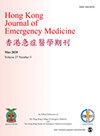体外膜氧合下经皮冠状动脉介入治疗急性心肌梗死引起的心脏骤停抢救的不良预后因素
IF 0.8
4区 医学
Q4 EMERGENCY MEDICINE
引用次数: 1
摘要
背景:急性心肌梗死引起的心脏骤停具有很高的死亡率。目的:探讨体外膜氧合联合经皮冠状动脉介入治疗抢救急性心肌梗死性心脏骤停的危险因素。方法:43例符合条件的患者分为死亡组和生存组。比较两组患者体外膜充氧后24、48、72 h的一般临床资料、治疗效果及各项指标。通过多因素logistic回归分析确定影响临床结果的因素。建立了nomogram预测模型并进行了验证。结果:取出体外膜氧合器后,恢复19例,死亡24例,死亡率为55.81%。两组常规心肺复苏时间、病变血管数、祸首血管分布、心脏骤停至体外膜氧合时间、重症监护住院时间、体外膜氧合后24、48 h平均动脉压差异有统计学意义(p < 0.05)。左前降支为罪魁祸首血管、病变血管数、常规心肺复苏时间、心脏骤停至体外膜氧合植入术时间、体外膜氧合复苏后48 h平均动脉压是死亡的独立危险因素。预测死亡率为72.6%,实际一致性指数(c指数)为0.869。经内外验证,该指标分别为0.861和0.848,一致性较好。结论:左前降支为罪魁祸首血管、病变血管数、常规心肺复苏时间、心脏骤停至体外膜氧合植入术时间、体外膜氧合复苏后48 h平均动脉压是急性心肌梗死性心脏骤停行体外膜氧合联合经皮冠状动脉介入治疗的独立危险因素。本文章由计算机程序翻译,如有差异,请以英文原文为准。
Adverse prognostic factors for rescuing patients with acute myocardial infarction–induced cardiac arrest receiving percutaneous coronary intervention under extracorporeal membrane oxygenation
Background: Acute myocardial infarction–induced cardiac arrest has high mortality rate. Objective: To investigate the risk factors of extracorporeal membrane oxygenation combined with percutaneous coronary intervention in rescuing acute myocardial infarction–induced cardiac arrest. Methods: Forty-three eligible patients were assigned into death and survival groups. Their general clinical data, treatment outcomes, and various indicators 24, 48, and 72 h after extracorporeal membrane oxygenation implantation were compared. The factors affecting clinical outcomes were determined by multivariate logistic regression analysis. A nomogram prediction model was constructed and validated. Results: After removing extracorporeal membrane oxygenation device, 19 patients recovered and 24 died (mortality rate: 55.81%). The two groups had different conventional cardiopulmonary resuscitation duration, number of diseased vessels, distribution of culprit vessel, time from cardiac arrest to extracorporeal membrane oxygenation implantation, length of stay in critical care unit, and mean arterial pressure 24 and 48 h after extracorporeal membrane oxygenation implantation (p < 0.05). Left anterior descending as the culprit vessel, number of diseased vessels, conventional cardiopulmonary resuscitation duration, time from cardiac arrest to extracorporeal membrane oxygenation implantation, and mean arterial pressure 48 h after extracorporeal membrane oxygenation resuscitation were independent risk factors for death. The predicted mortality rate was 72.6%, and the actual concordance index (C-index) was 0.869. Such indices after internal and external validations were 0.861 and 0.848, respectively, suggesting a good concordance. Conclusion: Left anterior descending as the culprit vessel, number of diseased vessels, conventional cardiopulmonary resuscitation duration, time from cardiac arrest to extracorporeal membrane oxygenation implantation, and mean arterial pressure 48 h after extracorporeal membrane oxygenation resuscitation are independent risk factors for patients with acute myocardial infarction–induced cardiac arrest undergoing extracorporeal membrane oxygenation combined with percutaneous coronary intervention.
求助全文
通过发布文献求助,成功后即可免费获取论文全文。
去求助
来源期刊

Hong Kong Journal of Emergency Medicine
EMERGENCY MEDICINE-
CiteScore
1.50
自引率
16.70%
发文量
26
审稿时长
6-12 weeks
期刊介绍:
The Hong Kong Journal of Emergency Medicine is a peer-reviewed, open access journal which focusses on all aspects of clinical practice and emergency medicine research in the hospital and pre-hospital setting.
 求助内容:
求助内容: 应助结果提醒方式:
应助结果提醒方式:


